How to Get Rid of Leaf Miners (With Pictures)
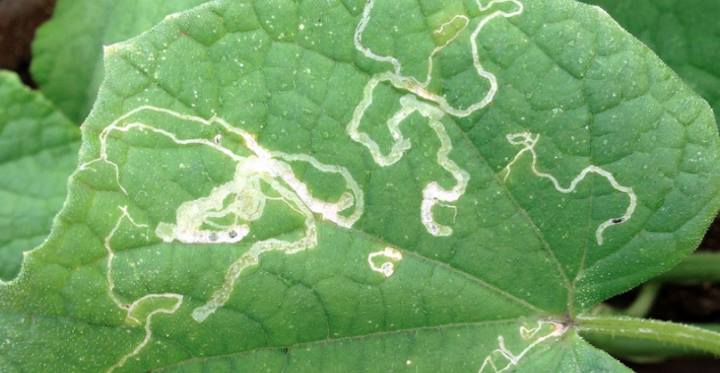
Leaf miners are larvae of various species of insects that live inside leaves and feed on leaf tissue. Leaf miner damage looks like discolored snaky lines or blotches on leaves that give foliage an unsightly look. Typically, mining larvae don’t kill plants, but feeding on plant tissue causes leaves to look bad and fall off. In severe cases, leaf miner attacks can affect the yield of greenhouse and garden crops as well as fruit trees.
It’s vital to get rid of leaf miners at the first signs of an infestation. The best ways of getting rid of leaf miners are to remove and destroy infected leaves, introduce beneficial insects, and spray affected plants with neem oil. Swift action to rid plants of leaf miners prevents the pesky larvae from affecting more plants.
This article is a complete guide to getting rid of leaf miners. You will find out about the best natural leaf miner insecticides and how to prevent leaf miner damage on leaves.
What Are Leaf Miners?
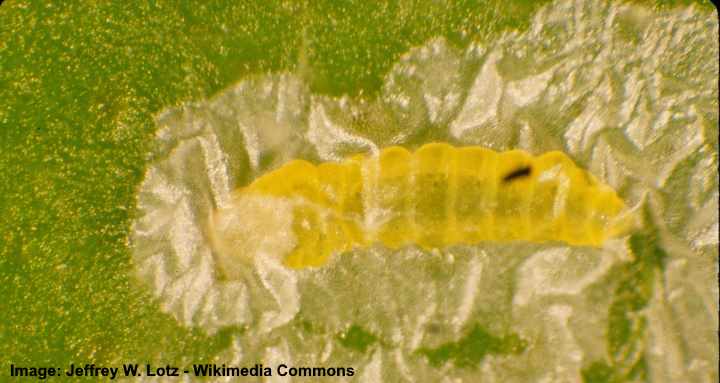
A close up image of citrus leaf miner larva (Phyllocnistis citrella)
Leaf miners are the larval stage of various types of flies, moths, sawflies, and some beetles. The minuscule larvae measure 0.04” to 0.07” (1 – 2 mm) in length. The tiny maggots tunnel in leaves, feeding on the soft tissue. You can see leaf miner damage by the shape of yellowish winding scars on leaf surfaces.
Various types of insects produce larvae that “mine” leaves. There are thousands of insect species considered to be leaf miners. Common types of leaf miners include spinach leaf miners (Pegomya hyoscyami), vegetable leaf miners (Liriomyza sativae), and citrus leaf miners (Phyllocnistis citrella).
Leaf Miner Life Cycle
The life cycle of a leaf miner starts as an egg that the female lays under the leaf’s surface. After seven to ten days, the eggs hatch into larvae and begin feeding on the leaf tissue. The destructive maggots tunnel through leaves leaving snake-like markings visible on the leaf’s surface.
A leaf miner larvae takes up to three weeks to develop in the leaves. During this time, it continually feeds on the leaf, causing damage to the leaf’s appearance and structure.
The leaf miner then burrows to the edge of the leaf, causing it to curl up. The leaf miner larvae goes into the pupal stage, where it takes between one and three weeks to develop into a leaf miner insect.
Adult leaf miners don’t damage plants or their foliage. The leaf miners live up to two weeks, during which time they will mate, and the female will again lay eggs in foliage.
The leaf miner life cycle takes between three and seven weeks to complete.
Leaf Miner Damage
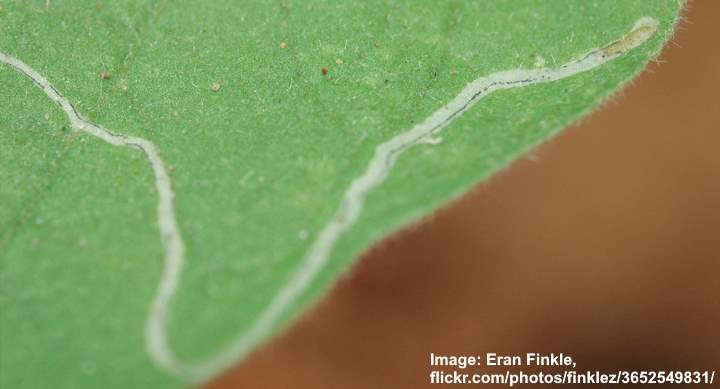
Damage of Liriomyza leaf miner larva
Leaf miners are so minuscule that it’s easiest to identify them by the damage they cause. Leaf miner damage looks like snaky whitish-yellow patterns on the foliage of broadleaf trees, fruit trees, shrubs, and vegetable greens. To prevent extensive plant damage, it’s vital to eradicate leaf miner larvae at the first signs.
Leaf miners primarily damage leaves. Broad foliage damage can affect the plant’s ability to photosynthesize and eventually weaken the plant. Apart from making the plant look diseased, leaf miner damage can affect a plant’s hardiness. A weakened plant caused by leaf miners is more susceptible to disease and won’t produce as many fruits, vegetables, or berries.
Even if your leafy greens such as spinach, cabbage, peas, and lettuce survive leaf miner damage, it’s hardly appetizing to eat vegetables that have discolored, sick-looking leaves.
How to Identify Leaf Miner
Leaf miner larvae and the adults are so tiny that they are challenging to identify. Usually, leaf miner identification is by the signs of leaf miner damage. Particular species of leaf miners prefer specific crops. You can generally tell the leaf miner species by the type of leaf that shows signs of damage.
Here are the identifying features of the most common types of leaf miners that can destroy plant foliage.
Citrus Leaf Miner
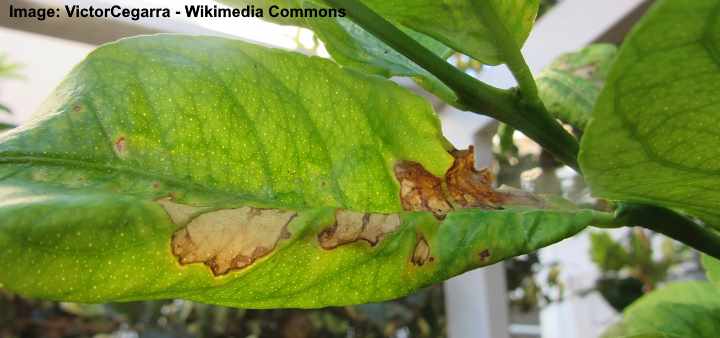
Damage caused by citrus leaf miner (Phyllocnistis citrella)
Citrus leaf miner (Phyllocnistis citrella) only burrows in the leaves of citrus trees. The larvae damage looks like thin, dark, well-marked meandering lines under the leaf’s surface. The edge of the leaf looks rolled up when the mining larvae enter the pupal state.
Adult citrus leaf miners are a light tan color with brown and white markings on each wing. Citrus leaf miners are 0.25” (0.5 cm) long and have long antennae.
Spinach Leaf Miner
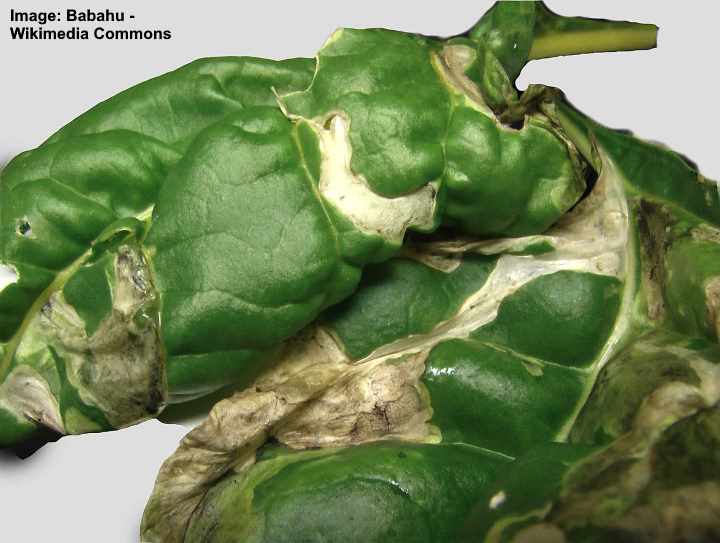
Damage to a chard leaf caused by spinach leaf miner (Pegomya hyoscyami)
The spinach leaf miner (Pegomya hyoscyami) is identified by yellowish, thin burrow markings winding on the leaf that end up like an unsightly blotch or blister. Spinach leaf miner larvae pupate on the soil, not in the leaf. Adult spinach leaf miners are gray flies about 0.25” (0.5 cm) long.
Spinach leaf miners attack leafy greens such as spinach, chard, beet, tomato, cucumber, and celery.
Vegetable Leaf Miner
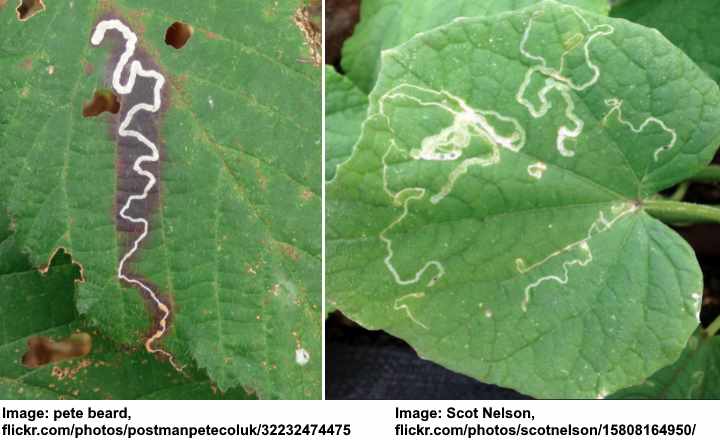
Pictures of leaf miner damage to vegetable leaves
The vegetable leaf miner (Liriomyza sativae) is identified by yellowish-white, twisting tunnels that start thin and gradually become wider. Close up, it may be possible to see the larvae burrowing in the leaf structure. Vegetable leaf miner “mining” activity doesn’t result in blotches—only snake-like patterns on the leaf’s surface.
Vegetable leaf miner larvae feed on pea, bean, eggplant, onion, squash, potato, pepper, and lettuce plants.
How to Get Rid of Leaf Miners
The best ways of getting rid of leaf miners without pesticides are to remove the leaves, use a neem oil spray, or introduce beneficial insects.
Getting rid of leaf miners and disrupting their lifecycle requires a multi-method approach. Because the burrowing pests live in leaves, sprays are not always effective for larvae. However, natural sprays can help kill pupae and adult leaf miners.
Let’s look in more detail at how to kill leaf miners that are destroying plant and vegetable leaves in your garden.
Physically Kill the Leaf Miner Eggs and Larvae
Kill leaf miner larvae by squashing leaves if you notice signs of “mining” activity. Keep an eye on your plant leaves in early spring when leaf miners become active. If you see the tell-tale signs of snake-like patterns on leaves, squeeze the part of the leaf where the burrow ends.
Squeezing leaves may be time-consuming if you have many crops or ornamental plants. But killing leaf miner larvae will prevent them from doing more significant damage to your plant foliage.
Remove Infected Leaves to Eliminate Leaf Miners
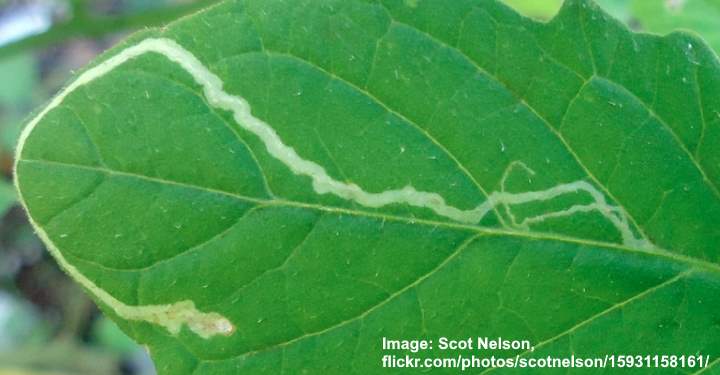
Tomato leaf damage caused by leaf miner
Get rid of leaf miners by removing any leaves that show signs of burrowing activity. All you need to do is use a sterilized pair of pruning shears to cut the leaves. To prevent further leaf miner attacks, discard the infected leaves in the garbage rather than composting them.
Beneficial Insects to Kill Leaf Miners
To get rid of leaf miners organically, introduce beneficial insects that feed on leaf miner adults and larvae. For example, parasitic wasps such as Diglyphus isaea kill leaf miner larvae before they pupate. Beneficial insects are most useful for eliminating leaf miner infestations indoors, such as greenhouses.
You can also use beneficial insects, such as ladybugs or lacewings, as a leaf miner prevention method. It would be best if you released them early in the seasons to destroy the larvae as soon as they hatch.
Use Sticky Traps to Control Leaf Miners
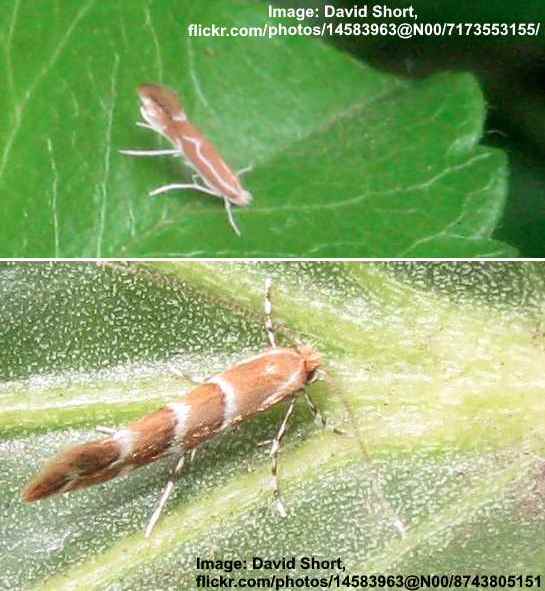
Yellow sticky traps help attract adult leaf miners. In the picture: adult firethorn leaf miner (top) and adult horse chestnut leaf miner (bottom)
Yellow sticky traps help reduce populations of leaf miners in greenhouses. The yellow color attracts adult leaf miner flies and moths, where they stick on the surface. Killing the leaf miners this way prevents them from mating during their short life cycle.
Neem Oil Spray to Get Rid of Leaf Miners
A homemade neem oil spray for leaf miners can help get rid of the plant-destroying insects. Mix 2 teaspoons neem oil, 1 teaspoon liquid dish soap, and 1 quart (1 l) of warm water. Combine the ingredients in a spray bottle and mix well. Spray liberally on foliage to kill leaf miners and prevent them from feeding.
For neem oil to work effectively, spray plant foliage every seven days until you get rid of the leaf miners for good.
Neem oil is effective against leaf miners and other bugs due to the natural insecticide azadirachtin. Spraying neem oil on plant leaves in early spring disrupts the leaf miner life cycle. Neem oil prevents adult leaf miners from feeding and laying eggs.
Scientific studies into the insecticidal effect of neem oil on leaf miners have found it to be effective. For example, some studies suggest that neem oil retards leaf miner growth, inhibits feeding, and is toxic to larvae.
Spinosad Leaf Miner Spray
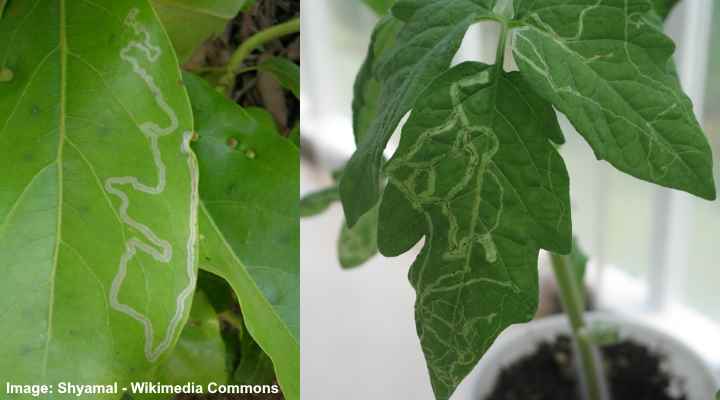
You can use Spinosad spray as a leaf miner insecticide
Spinosad sprays can help to kill leaf miners by interfering with their life cycle. Spinosad is a naturally occurring soil microorganism that has a detrimental effect on some insects. Solutions containing Spinosad are easy to use on plants, and you only need to follow the manufacturer’s instructions.
For example, Spinosad solutions are added to a spray bottle that attaches to your garden hose. You then spray plants with the natural solution every four to seven days until you no longer have problems with leaf miners.
There is also scientific evidence supporting the use of Spinosad for natural leaf miner control. A 2018 study found that using Spinosad helped to kill off tomato leaf miners in greenhouses. The natural solution was most effective when used along with other leaf miner eradication and control methods.
A word of caution when using Spinosad on leaf miners: Spinosad can affect beneficial insects such as parasitic wasps for up to three hours after application. It is only recommended to use Spinosad up to six times a year to control leaf miners.
How to Prevent Leaf Miners
The best way to keep your plant foliage looking healthy and free from leaf miners is to prevent the plant-destroying insects from laying eggs. Many ways to kill leaf miners can also control the flying pests if you use them early in the season.
Here are some additional methods of preventing leaf miners from becoming a significant pest in your garden.
Protect Plants from Leaf Miners by Checking Leaves Regularly
Regularly check young plants for evidence of leaf-mining activity. Usually, adult leaf miners lay eggs on young, new leaves. If you notice burrowing, squeeze the leaves to kill off any larvae munching through your plant leaves.
Remove Weeds from Gardens to Prevent Leaf Miners
Good gardening habits, such as weed removal, are also beneficial to prevent leaf miners from becoming a major pest. Remove pigweed, chickweed and lamb’s quarters from your garden as they attract certain types of vegetable leaf miners.
It’s also beneficial to till the soil before planting any vegetables or green leafy crops. Tilling buries leaf miner pupae and also helps prevent problems with grasshoppers.
Floating Row Covers to Protect Against Leaf Miners
Prevent leaf miners on your vegetables by using row covers to protect plants from attack. Using a natural material such as cheesecloth helps to keep leaf miners away from plants. This prevents the flying pests from laying eggs that destroy your plant leaves.
Using row covers for leaf miner prevention only works if there hasn’t been an insect infestation within the previous year. Suppose you suspect you already have leaf miners on ornamental plants or vegetables. In that case, you’ll need to use an alternative control method.
Companion plants
Prevent leaf miners from damaging crops by planting companion plants. Some plants attract leaf miners. While this may sound counterintuitive, plants that attract leaf miners will keep them away from your prized citrus trees and leafy greens.
For example, if you have lamb’s quarter growing, dig it up and plant it at the perimeter of your garden. Many species of leaf miners will lay their eggs there rather than on other plants in your garden.
Healthy Plants Prevent Leaf Miners
One way to prevent leaf miner damage on leaves is to grow healthy garden plants. Organic gardening techniques using compost and fertilizers improve a plant’s hardiness. This makes the plant less susceptible to leaf miners and other garden pests. It is also essential to use proper watering techniques, keep soil healthy, and prune shrubs, bushes, and citrus trees appropriately.
How to Get Rid of Citrus Leaf Miner
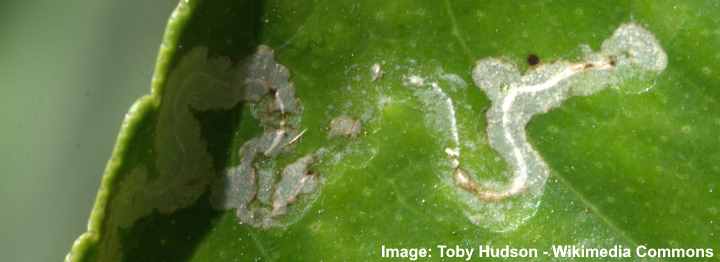
Citrus leaf miner damage
Citrus leaf miners can be a particular nuisance if you have lemon, orange, or lime trees. Mining pests such as the Citrus leaf miner (Phyllocnistis citrella) can damage citrus leaves. Although citrus leaf miners don’t affect the yield on mature trees, it can make them look sick and unsightly. Also, citrus leaf miners can have an impact on immature trees.
Natural pesticide sprays to get rid of citrus leaf miners
The University of California says that natural insecticide sprays containing neem oil or Spinosad can be effective against larvae. It is necessary to apply the organic sprays every seven days to help kill off larvae and reduce the impact of leaf miner activity.
Parasitic wasps
Biological control is also useful for eradicating citrus leaf miners by introducing parasitic wasps. Non-stinging wasps in the Cirrospilus and Pnigalio genera are especially useful in killing leaf miner larvae.
Bacillus thuringiensis to get rid of citrus leaf miners
Bacillus thuringiensis (Bt) is a naturally occurring soil bacteria that you can use to control leaf miners organically. Bt is useful in leaf miner control because it doesn’t harm beneficial insects such as parasitic wasps. You should follow the manufacturer’s instructions on spraying citrus trees with Bacillus thuringiensis to eradicate leaf miners.
Scientific research also suggests that Bacillus thuringiensis can be useful in controlling citrus leaf miners. Spraying citrus trees with a Bt solution helped kill off the leaf miner larvae without resorting to pesticides.
How to Prevent Citrus Leaf Miner
Using parasitic wasps is one of the best ways to manage populations of citrus leaf miners. Some studies show that the parasitic wasp Ageniaspis citricola is useful for preventing citrus leaf miner damage on citrus trees.
Another way to prevent citrus leaf miners from causing damage to tree foliage is by removing new shoots at the base of the tree. Citrus tree suckers grow new foliage that attracts leaf miners. So, if you have a few citrus trees, always remove vigorous shoots that grow at the trunk’s base.
Related articles:
